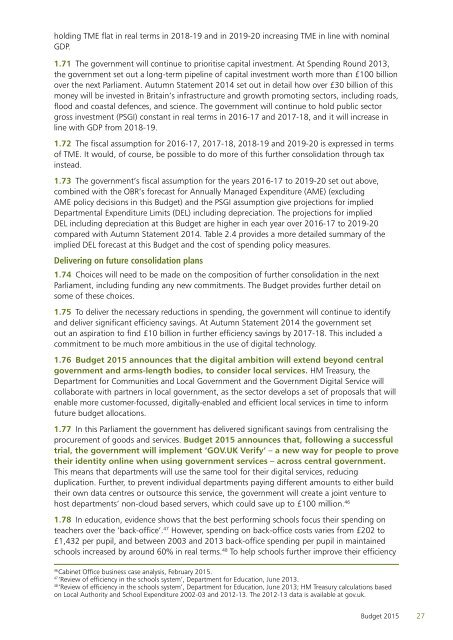Create successful ePaper yourself
Turn your PDF publications into a flip-book with our unique Google optimized e-Paper software.
holding TME flat in real terms in 2018-19 and in 2019-20 increasing TME in line with nominalGDP.1.71 The government will continue to prioritise capital investment. At Spending Round 2013,the government set out a long-term pipeline of capital investment worth more than £100 billionover the next Parliament. Autumn Statement 2014 set out in detail how over £30 billion of thismoney will be invested in Britain’s infrastructure and growth promoting sectors, including roads,flood and coastal defences, and science. The government will continue to hold public sectorgross investment (PSGI) constant in real terms in 2016-17 and 2017-18, and it will increase inline with GDP from 2018-19.1.72 The fiscal assumption for 2016-17, 2017-18, 2018-19 and 2019-20 is expressed in termsof TME. It would, of course, be possible to do more of this further consolidation through taxinstead.1.73 The government’s fiscal assumption for the years 2016-17 to 2019-20 set out above,combined with the OBR’s forecast for Annually Managed Expenditure (AME) (excludingAME policy decisions in this <strong>Budget</strong>) and the PSGI assumption give projections for impliedDepartmental Expenditure Limits (DEL) including depreciation. The projections for impliedDEL including depreciation at this <strong>Budget</strong> are higher in each year over 2016-17 to 2019-20compared with Autumn Statement 2014. Table 2.4 provides a more detailed summary of theimplied DEL forecast at this <strong>Budget</strong> and the cost of spending policy measures.Delivering on future consolidation plans1.74 Choices will need to be made on the composition of further consolidation in the nextParliament, including funding any new commitments. The <strong>Budget</strong> provides further detail onsome of these choices.1.75 To deliver the necessary reductions in spending, the government will continue to identifyand deliver significant efficiency savings. At Autumn Statement 2014 the government setout an aspiration to find £10 billion in further efficiency savings by 2017-18. This included acommitment to be much more ambitious in the use of digital technology.1.76 <strong>Budget</strong> <strong>2015</strong> announces that the digital ambition will extend beyond centralgovernment and arms-length bodies, to consider local services. HM Treasury, theDepartment for Communities and Local Government and the Government Digital Service willcollaborate with partners in local government, as the sector develops a set of proposals that willenable more customer-focussed, digitally-enabled and efficient local services in time to informfuture budget allocations.1.77 In this Parliament the government has delivered significant savings from centralising theprocurement of goods and services. <strong>Budget</strong> <strong>2015</strong> announces that, following a successfultrial, the government will implement ‘GOV.UK Verify’ – a new way for people to provetheir identity online when using government services – across central government.This means that departments will use the same tool for their digital services, reducingduplication. Further, to prevent individual departments paying different amounts to either buildtheir own data centres or outsource this service, the government will create a joint venture tohost departments’ non-cloud based servers, which could save up to £100 million. 461.78 In education, evidence shows that the best performing schools focus their spending onteachers over the ‘back-office’. 47 However, spending on back-office costs varies from £202 to£1,432 per pupil, and between 2003 and 2013 back-office spending per pupil in maintainedschools increased by around 60% in real terms. 48 To help schools further improve their efficiency46Cabinet Office business case analysis, February <strong>2015</strong>.47‘Review of efficiency in the schools system’, Department for Education, June 2013.48‘Review of efficiency in the schools system’, Department for Education, June 2013; HM Treasury calculations basedon Local Authority and School Expenditure 2002-03 and 2012-13. The 2012-13 data is available at gov.uk.<strong>Budget</strong> <strong>2015</strong>27


